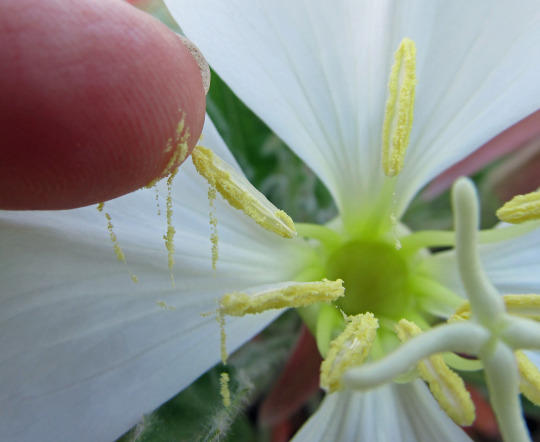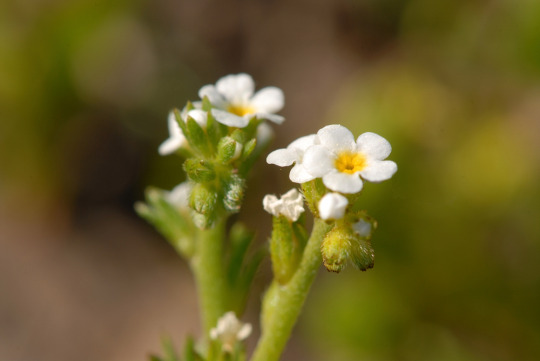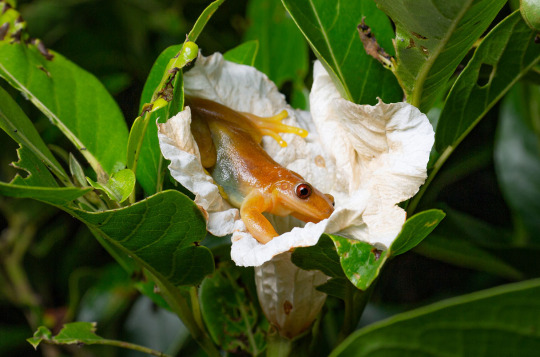#pollen grain
Explore tagged Tumblr posts
Photo

Against the Grain
The intelligent part of artificial intelligence (AI) is mimicking our thought processes – making decisions based on logic and knowledge, and perhaps learning new rules along the way to hone these choices. But as deep-learning models grow more complex, the logic driving them can be lost in the code. Pictured under a scanning electron microscope, spotting different varieties of pollen grains, is a fresh challenge for artificial intelligence. A team of computer scientists and bioengineers sort grains by their different chemical and shape (morphological) properties using a form of explainable AI (xAI) – in which the artificial ‘thought processes’ are transparent and easy to follow. Apart making an excellent testing ground for xAI methods, the team are able to compare different models for classifying pollen, which may ultimately improve how we estimate pollen counts, make forecasts and promote advice to millions of people suffering allergies worldwide.
Written by John Ankers
Image from work by Sanja Brdar and colleagues
BioSense Institute - Research Institute for Information Technologies in Biosystems, University of Novi Sad, Novi Sad, Serbia
Image originally published with a Creative Commons Attribution 4.0 International (CC BY 4.0)
Published in Scientific Reports, February 2023
You can also follow BPoD on Instagram, Twitter and Facebook
#science#biomedicine#artificial intelligence#pollen#allergy#pollen grain#electron microscopy#explainable AI#AI
12 notes
·
View notes
Text

TSRNOSS, p 710.
#pipecolic acid#grain dust explosion#pollen grain#deep sea fish#distribution of molecular velocities#Peruvian mummies#nitrates in the soil#sunburn#ultraviolet absorption by biomolecules#early Earth#cloud cover
0 notes
Text
Not sure if anyone would be into this but we were dissecting flowers in lab and I got some up close photos of pollen. Thought some people might want to see what’s really up there tickling peoples noses



#dicotyledonous flowers have pollen that looks like this#round and spiky that just sticks to the inside of your nose#it’s no wonder everyone gets so sneezing in the spring with all that pollen floating around in the air#one flower produces thousands of pollen grains just like the one pictured above#any other snzfuckers STEM majors out there?#snz kink#snzblr#snz blog#snz fet#snz fucker#snz#snzfucker#sneeze kink#allergies#allergy sneezes#allergy snz#pollen sneezes
111 notes
·
View notes
Text

Depth color-coded projection showing a germinating pollen grain of a morning glory attached to the stigma.
By Igor Siwanowicz (USA).
Light Microscopy Awards
#igor siwanowicz#photographer#united states#light microscopy awards#germinating pollen grain#nature#morning glory
28 notes
·
View notes
Text
Another Year of Pollination: Viscin Threads
While we’re on the subject of pollen-gluing mechanisms, there is another material apart from pollenkitt that a limited number of flowering plant families use to link their pollen grains together. It functions, much like pollenkitt, by aiding in the attachment of pollen to visiting animals. However, unlike pollenkitt, it isn’t sticky, oily, or viscous, and is instead more like a series of threads.…

View On WordPress
#bees#birds#Caesalpinioideae#Ericaceae#flowers#fossil record#Lepidoptera#Oenothera#Onagraceae#plant anatomy#plant science research#pollen#pollen grains#pollenkitt#pollinators#Rhododendron#viscin threads#year of pollination
18 notes
·
View notes
Text
some actors i have like major crushes on… and some i just think of like the fun uncles that show up and make family gatherings actually bearable. like i am not at all attracted to these actors, they just give me big “fun at parties, but like in a paternal-adjacent kinda way” energy. a few of these actors include:
pedro pascal (massive tío energy coming from this guy. the more i learn about him, the more i begin to think that he was just born to be somebody’s like really cool uncle and then happened to become a celebrity)
ben affleck (especially after seeing the legendary dunkin fumbles and the fact that he’s just fucking incredible at communicating in spanish?? yet he’s just some white dude from boston?? like that’s so iconic of him and also incredibly uncle-coded)
bradley cooper (seems like the stoner uncle that doesn’t come around a lot, but when he does, he’s cool and like it’s always fun)
colin firth (posh spice uncle)
anthony mackie (the very definition of fun. he’s the ultimate funcle - fun uncle… but he would also [jokingly] hate when you call him that [like not really hate?? but he’d be like ‘come on, man!!’ y’know??]. absolutely gets you in trouble for laughing during some like family event or something, but he’ll always take the fall for you because funcle’s never let their niblings/nieces/nephews get in trouble, if they can help it… if they can’t, well, then they’re always there to make you laugh in the aftermath)
9 notes
·
View notes
Note
lovely scorpoid raceme in your lab pic, as a california botanist I am wondering what kinds of flowers from california you’re looking at!
Hi!! sorry this took me a while to respond to, we use 4-letter codes for all the plants and I couldnt remember the actual name of the one I was working on that day and had to find the document with all the names lmaO
The lab I'm in works mainly with plants in the serpentine seeps around Lower Lake, CA! I think in total we work with around 40-ish species from that area? It's a community ecology lab so not as much on the actual plant physiology and anatomy but LOTS of stuff about pollination (particularly plant-pollinator interaction patterns).
anyway the one in the pic was Plagiobothrys stipitatus! These guys:

Some of the other plants we work with that i think are cool are Erythranthe nudata, Leptosiphon bicolor (BARELY ANY SEEDS IN THIS BITCH), Lagophylla minor, Antirrhinum vexillocalyculatum, and Zigadenus venenosus. Lots of others but i will not bore u by listing them all out kfasjdfjk
My current job of collecting seeds is in preparation for next spring when we'll be starting a greenhouse experiment to try and grow the flowers and manipulate the amount and type of pollen they receive :-)
#my previous job was processing styles that had been collected from all the flowers and dyeing them with analine blue#to count number of pollen grains (and types of pollen) and the number of pollen tubes they produced#its interesting stuff! kind of tedious but i dont mind it hehe#asks#jawjackin#academia
11 notes
·
View notes
Text
my throat is KILLING ME
2 notes
·
View notes
Text
Elevate Your Nutrition with Bee Pollen Grains

When it comes to natural superfoods, bee pollen grains are a powerhouse of nutrition. Packed with essential vitamins, minerals, and enzymes, bee pollen offers a plethora of health benefits. In this blog post, we will explore the wonders of bee pollen and guide you on where to buy this nutritional gem to elevate your nutrition.
The Marvelous Benefits of Bee Pollen Grains
Bee pollen grains are tiny golden granules collected by honeybees from flowering plants. They are rich in protein, amino acids, antioxidants, and a wide range of nutrients that can support overall health and well-being. Incorporating bee pollen into your diet can provide several potential benefits: Boosted Immunity, Increased Energy,
With its impressive nutritional profile and potential health benefits, bee pollen grains can be a valuable addition to your diet. By purchasing bee pollen from Geohoney so you can ensure the quality and freshness of the product.
Embrace the wonders of bee pollen grains and elevate your nutrition to new heights. Discover the natural power of this superfood and enjoy the wide range of benefits it can provide for your overall health and well-being.
1 note
·
View note
Text
Question:
The anther contains :
(a) sepals (b) ovules
(c) pistil (d) pollen grains
Answer:
(d) pollen grains
0 notes
Text

The Science Diaries of S. Sunkavally, p 695.
#carbon suboxide#photorespiration#neurotransmitter#glutamate#autonomic ganglia#EPSP#IPSP#blood-brain barrier#embryo sac#triploid endosperm#polyploidy#pollen grains
0 notes
Text

Brazilian frog might be the first pollinating amphibian known to science
Nectar-loving tree frog likely moves pollen from flower to flower.
The creamy fruit and nectar-rich flowers of the milk fruit tree are irresistible to Xenohyla truncata, a tree frog native to Brazil. On warm nights, the dusky-colored frogs take to the trees en masse, jostling one another for a chance to nibble the fruit and slurp the nectar. In the process, the frogs become covered in sticky pollen grains—and might inadvertently pollinate the plants, too. It’s the first time a frog—or any amphibian—has been observed pollinating a plant, researchers reported last month in Food Webs...
Read more: https://www.science.org/content/article/brazilian-frog-might-be-first-pollinating-amphibian-known-science
3K notes
·
View notes
Text
This Brazilian frog might be the first pollinating amphibian known to science
Nectar-loving tree frog likely moves pollen from flower to flower

The creamy fruit and nectar-rich flowers of the milk fruit tree are irresistible to Xenohyla truncata, a tree frog native to Brazil. On warm nights, the dusky-colored frogs take to the trees en masse, jostling one another for a chance to nibble the fruit and slurp the nectar. In the process, the frogs become covered in sticky pollen grains—and might inadvertently pollinate the plants, too. It’s the first time a frog—or any amphibian—has been observed pollinating a plant, researchers reported last month in Food Webs.
Scientists long thought only insects and birds served as pollinators, but research has revealed that some reptiles and mammals are more than up to the task. Now, scientists must consider whether amphibians are also capable of getting the job done. It’s likely that the nectar-loving frogs, also known as Izecksohn’s Brazilian tree frogs, are transferring pollen as they move from flower to flower, the authors say. But more research is needed, they add, to confirm that frogs have joined the planet’s pantheon of pollinators.
Source.
7K notes
·
View notes
Text
Another Year of Pollination: Pollenkitt
Pollination in flowering plants is the process of moving pollen grains, which carry sperm cells, from the anthers to the stigmas of either the same flower or a separate flower. If things go well from there, sperm cells will be transported via pollen tubes into the ovaries where fertilization with egg cells can take place and seeds can form. Pollen grain development occurs within the anthers, and…

View On WordPress
#animal pollination#bees#Botany#floral anatomy#flowers#insect pollination#plant ecology#plant science research#pollen#pollen grains#pollenkitt#pollination#pollinators#wind pollination#year of pollination
18 notes
·
View notes
Text
@chrrymunson my beloved <3
#arden likes a lot of my posts#which means he validates me#bc one like = one validation#we know this#so he’s now the favorite child#the pollen grain of the month if you will#actually.. i kinda like that#okay new thing#pollen grain of the month <3
4 notes
·
View notes
Photo

1 note
·
View note